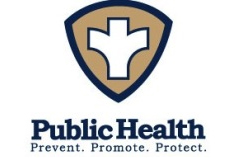Middle-Brook Regional
Health Commission
“Healthy People and Places – A Healthy Community”
Serving Green Brook, Warren, Watchung and Bridgewater
“Healthy People and Places – A Healthy Community”
Serving Green Brook, Warren, Watchung and Bridgewater
The key things to keep in mind when creating a healthy diet plan, are to consume nutrient-dense foods and beverages, vary your options within the food groups (vegetables, fruits, grains, protein, dairy, oils/fats), be mindful of your portion size, and limit your intake of red and processed meats, sugar-sweetened foods and beverages, and refined grains (white flour products, white rice). Unlike the latter, nutrient-dense foods provide a high amount of nutrients and a low number of calories. Examples are fruits and vegetables, herbs, fish, eggs, beans, raw nuts and seeds, lean meats and poultry, and whole grains.
Just like a rainbow, fruits and vegetables come in an assortment of colors, with each color offering different nutritional benefits. For example, some of the vitamins and minerals found in red fruits and vegetables are lycopene and iron. Orange and yellow colors signify a high amount of beta carotene and Vitamin C, and green fruits and veggies are high in folic acid, potassium, and Vitamins A and K. The same goes for the multiple varieties of herbs, grains, beans, nuts and seeds. Beans are a great source of protein and fiber, as are certain grains like quinoa, and nuts and seeds offer healthy omega-3 and omega-6 fatty acids. Herbs offer health and medicinal benefits. They provide multiple vitamins, minerals and electrolytes, and have been used to treat health ailments for thousands of years.
Another important factor to keep in mind is the amount of food or calories you eat. When you sit down for a meal, start out with a smaller amount of food on your plate. When we’re hungry our eyes want to devour everything, but the key is to stop eating when you feel satisfied, not full. The recommended number of daily calories is 2,000 a day, but it really varies depending on your age, activity level, if you’re trying to lose weight and other factors. Talk to your healthcare provider to determine what you should be consuming.
A great way to incorporate a variety of fresh, healthy and in season food, is to shop at a farm or farmer’s market, or to purchase a CSA membership. Farms are fun to visit with the whole family, and you can either pick your own produce directly from the fields or shop at their market on site. At a farmer’s market you can browse and shop from various vendors for things like fresh produce, pasture-raised meats, dairy products, baked goods and other items. A CSA membership is for those who don’t want to do their own shopping. All you have to do is stop by the farm once a week and pick up a pre-selected box of seasonal produce. Memberships typically run throughout the summer and fall seasons.
Here are examples of healthy recipes for each meal of the day, as well as tasty desserts and snacks.
Breakfast:
Apple Slice Pancakes
Avocado Breakfast Bruschetta
Banana Walnut Oatmeal
Peanut Butter Banana Smoothie
Lunch:
Apple Cranberry Salad Toss
Avocado, Potato and Grilled Chicken Salad
Black Bean Soup
Turkey and Cucumber Sandwich
Dinner:
Black Bean Burgers
Brown Rice with Sizzling Chicken and Vegetables
Easy Fried Rice
Easy Oven Packet Caribbean Tilapia with Pears and Carnival Roasted Potatoes
Dessert:
Apple Pistachio Crisp
Aunt Barbara’s Chocolate Squash Cake
Pear Kabobs with Strawberry Dipping Sauce
Pumpkin Pudding
Snacks:
Veggies & hummus – carrot, celery and cucumber sticks, bell pepper slices, broccoli and cauliflower florets, cherry tomatoes
Trail mix – sunflower and pumpkin seeds, almonds and walnuts, cranberries or raisins
Roasted chickpeas
Guacamole and baked tortilla chips
Multi-grain bread or bananas with peanut or almond butter
Multi-grain crackers with canned or smoked salmon and dill
Fruits – apple and pear slices, orange and grapefruit slices, green or red grapes, fruit salad
Fruit and veggie smoothie – almond milk, berries, spinach, avocado, banana
For more information, visit www.heart.org/how-can-i-eat-more-nutrient-dense-foods, www.heart.org/healthy-snacking, www.health.harvard.edu/add-color-to-your-diet-for-good-nutrition and www.myplate.gov
